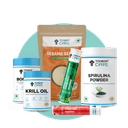We assure you that you won’t be alone on your journey towards becoming your healthier self.
Health & Wellness
Decoding And Understanding The Difference Between Vitamin D And D3

You must have often heard about taking vitamin D for stronger bones, but did you know about vitamin D3? Wondering if that even exists? Like vitamin D, vitamin D3 is also crucial. They are both fat-soluble vitamins necessary for bone health and immune function. Then, what is the difference between vitamin D and D3? While vitamin D aids in absorbing essential minerals like calcium, D3, also known as cholecalciferol, is synthesised distinctly by our bodies when exposed to sunlight or obtained from certain foods.
Although vitamin D and vitamin D3 are sometimes used synonymously, they are different. In simpler terms, vitamin D improves the absorption of calcium, iron, magnesium, phosphate, and zinc through the digestive tract. Conversely, when the skin is exposed to sunshine, it naturally produces vitamin D3, also referred to as cholecalciferol. However, despite their similar roles, inadequate levels of both types are widespread, affecting approximately one billion people worldwide, as the National Institutes of Health reported.
Insufficient vitamin D can lead to various health issues, including increased infection risks, osteoporosis, and autoimmune conditions. While both forms are vital, D3 is often preferred for supplements due to its superior bioavailability and longer-lasting effect. Moreover, certain meals and supplements can provide it. Both are necessary for many body processes, such as immune system support and bone health. Still, their sources and chemical compositions vary slightly, which affects how the body absorbs and uses them. Read ahead to comprehend vitamin D and D3 differences to maximise dietary consumption and health benefits.
Table Of Contents
1. What Is The Difference Between Vitamin D And D3?
2. Expert Advice
3. The Final Say
4. FAQs
5. References
What Is The Difference Between Vitamin D And D3?
A class of fat-soluble secosteroids known as vitamin D improves the absorption of calcium, iron, magnesium, phosphate, and zinc through the digestive tract. Vitamin D is a group, and vitamin D3 is part of this group. There are numerous benefits of vitamin D for men and women. It is essential for the body's immunological system, bones, and many other physiological functions. The vitamin D group has two primary forms: vitamin D2 (ergocalciferol) and vitamin D3 (cholecalciferol).
| Vitamin D | Vitamin D3 | |
| Chemical Composition |
|
|
| Sources and Production |
|
|
Also Read- Best Vitamin D Supplements For Adults And Daily Dosage
Dietitian's Recommendation
As a dietitian, I recommend ensuring adequate vitamin D intake, focusing on vitamin D3, for overall health. This vitamin along with calcium is crucial for bone strength, immune function, and mood regulation. Incorporate vitamin D-rich foods such as egg yolks, fatty fish, and dairy products that have been fortified. Also, spend time safely in the sun for natural vitamin D3 production, especially early morning sunlight, as later, the intensity of UV rays increases. Several nutrients are indispensable in absorbing vitamin D, namely, Ca, magnesium, vitamin K, phosphorus, and essential fatty acids, as it is a fat-soluble vitamin. Hence, taking these nutrient-rich sources will also help our body absorb Vitamin D. If needed, one can also consider ToneOp Care’s Vitamin 360 tablets for maintaining optimum levels of vitamin D and vitamin D3 in your body.
The Final Say
To sum up, the distinction between vitamin D and D3 lies in their chemical structures and sources. While both are crucial for various bodily functions like bone health and immune system support, vitamin D3, known as cholecalciferol, is considered the more active form. It is primarily produced in the skin when exposed to sunlight or found in animal-based foods. Scientific studies consistently show that our bodies absorb and use vitamin D3 more effectively than vitamin D2, leading to higher and longer-lasting vitamin D levels in our bloodstream. So, vitamin D3 may offer better results in maintaining overall health and well-being when choosing supplements or planning our diet.


